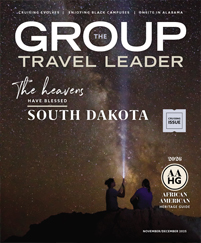Chattahoochee-Oconee National Forests
It is said that the name Chattahoochee descends from the local native dialect and means “flowered stone.” Entering the forest, rife with streams and waterfalls softening and bringing a wealth of life to the stone ridges of the Appalachians, visitors will find the name apt.
Lining much of Georgia’s northern border with North Carolina, the combined Chattahoochee-Oconee national forests include 850 miles of trails winding through 867,000 acres of woodlands and waterways. The Chattooga River, which flows through the forest but is managed by the National Park Service, is one of the last unaltered streams in the Southeast and is popular with rafters.
Though hiking is the primary activity here, where the Appalachian Trail has its start, groups can take a quicker way through the forest on the Ridge and Valley Scenic Byway, which hugs the Appalachians. Groups can also drive right up to 4,784-foot-high Brasstown Bald, Georgia’s highest mountain, and either walk the 0.6-mile trail to the top that ascends 500 feet over its short course or take the shuttle to the summit.
Cumberland Island National Seashore
Limited to just 300 visitors a day, Georgia’s Wild West on the wild Atlantic is worth booking ahead. Home to wild horses, deer, 323 species of birds and a thriving sea turtle nest population, Cumberland Island, one of Georgia’s Golden Islands, feels 100 miles from civilization rather than its actual 7-mile distance from St. Mary’s.
One of the best ways to experience the island is to book an overnight at one of the island’s campsites. The best site for groups is Sea Camp, adjacent to the main visitor center where afternoon ranger-led talks introduce visitors to the island’s history and natural inhabitants.
“If you want fire rings and running-water showers, Sea Camp is right at the ranger station and the beach,” said Doug Hoffman, biologist for the Cumberland Island National Seashore. “In terms of attractiveness, I’d recommend Brick Hill on the northeast corner of the island where the river winds in. It’s popular for kayak, canoe and private boat users because you can tie off the boat and camp right there.”
Hoffman also recommends visiting in the winter, during migratory season, when up to 20,000 shorebirds take up temporary residence on the beaches.
Sapelo Island
While each of the islands dotting Georgia’s coastline has developed its own unique character over the years, Sapelo’s is difficult to pin down. Though its wildlife is protected through the Georgia State Park Service, Sapelo’s majestic, marble-filled Reynolds Mansion welcomes overnight visitors with the state’s customary Southern hospitality — home-style cooking included.
“Some people have been coming for 34 years without missing a single year,” said James Maund, the general manager of Reynolds Mansion. “Eighty-eight percent of our business is repeat, but you can go to the beach on Fourth of July weekend and not find 15 people on it. One of the strange things about this crazy place is nothing is black-and-white.”
Even if not staying overnight, groups can arrange one- to four-hour historic tours of the mansion with Maund and his staff. Ranger-led tours of the island, including the 85-foot functioning lighthouse and Hog Hammock, an African-American community descended from the slaves who once worked the island’s plantation, can last from one to eight hours.
The 30-minute ferry to Sapelo leaves from Meriden, about an hour south of Savannah, and the number of ferries varies by day, with five ferries daily on Monday, Wednesday, Friday and Saturday. The mansion can accommodate 29 guests at one time.









